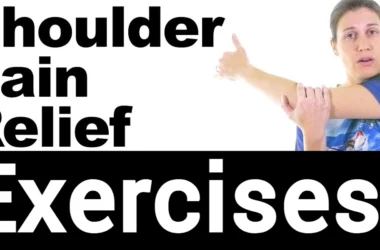Shingles, also known as herpes zoster, is a painful skin rash caused by the varicella-zoster virus, the same virus responsible for chickenpox.
This virus can remain dormant in the body for years and reactivate later in life, leading to shingles.
Understanding the symptoms, causes, and treatment options for shingles is crucial for managing this condition effectively.
What is Shingles?
Shingles is a viral infection characterized by a painful rash that usually appears on one side of the body or face.
The rash often forms a stripe of blisters that wraps around either the left or right side of the torso. Although shingles is not a life-threatening condition, it can be extremely painful.
Symptoms of Shingles
Shingles, also known as herpes zoster, manifests through several distinct symptoms. Early recognition of these symptoms is crucial for prompt treatment and relief. The primary symptoms of shingles include:
1. Pain and Tingling
The first noticeable symptom is often a burning or tingling pain in a specific area on one side of the body. This pain can be intense and is typically localized to the path of a nerve.
2. Red Rash
A red rash usually appears within a few days of the onset of pain. This rash often forms a stripe of red, inflamed skin, following the affected nerve’s path.
3. Fluid-Filled Blisters
The red rash soon develops into clusters of fluid-filled blisters. These blisters can break open and crust over, causing additional discomfort.
4. Itching
The area with the rash and blisters can become extremely itchy, adding to the discomfort.
5. Fever
Some individuals may experience a mild fever, which often accompanies the initial stages of the rash.
6. Headache
A headache is another common symptom that can occur along with or before the appearance of the rash.
7. Sensitivity to Light
In some cases, shingles can cause sensitivity to light, making it uncomfortable to be in brightly lit environments.
8. Fatigue
General fatigue and a feeling of being unwell are also common symptoms, often persisting throughout the course of the illness.
These symptoms can vary in intensity and duration, with the pain potentially lasting even after the rash has healed.
Recognizing these symptoms early can help individuals seek medical treatment promptly, which can significantly reduce the severity and duration of the illness.
Causes and Risk Factors
Shingles is caused by the reactivation of the varicella-zoster virus, the same virus responsible for chickenpox.
After a person recovers from chickenpox, the virus remains dormant in their nervous system.
Years or even decades later, the virus can reactivate, causing shingles. Understanding the causes and risk factors can help in identifying those most at risk and taking preventive measures.
Primary Cause: Varicella-Zoster Virus Reactivation
The primary cause of shingles is the reactivation of the varicella-zoster virus. Once a person has had chickenpox, the virus lies inactive in nerve tissue near the spinal cord and brain.
For reasons not fully understood, the virus can reactivate later in life, traveling along nerve pathways to the skin, resulting in shingles.
Risk Factors
Several factors can increase the likelihood of the varicella-zoster virus reactivating and causing shingles:
1. Age
- Older Adults: The risk of developing shingles increases with age. Individuals over 50 are particularly at higher risk. As people age, their immune systems weaken, making it easier for the virus to reactivate.
2. Weakened Immune System
- Medical Conditions: Conditions that weaken the immune system, such as HIV/AIDS or cancer, increase the risk of shingles.
- Medications: Certain medications, including steroids and drugs used to prevent rejection of transplanted organs, can lower the body’s immunity and raise the risk of shingles.
3. Stress
- Emotional and Physical Stress: High levels of stress can weaken the immune system, making it more susceptible to viral reactivation. Both physical and emotional stress have been linked to an increased risk of developing shingles.
4. Previous Chickenpox Infection
- History of Chickenpox: Anyone who has had chickenpox is at risk for shingles, as the virus remains in the body. The risk does not disappear and can reemerge at any time.
5. Gender
- Women: Some studies suggest that women might be at a slightly higher risk of developing shingles compared to men.
6. Certain Medical Treatments
- Cancer Treatments: Chemotherapy and radiation can weaken the immune system, increasing the risk of shingles.
- Organ Transplants: Post-transplant medications that suppress the immune system can also heighten the risk.
By understanding these risk factors, individuals can be more vigilant in monitoring their health and seeking medical advice if they fall into any high-risk categories. Additionally, vaccination and maintaining a healthy lifestyle can help mitigate some of these risks.
Diagnosing Shingles
Diagnosing shingles accurately and promptly is essential for effective treatment and relief. Healthcare providers typically use a combination of patient history, physical examination, and, in some cases, laboratory tests to diagnose shingles.
Patient History
The diagnostic process often begins with a detailed patient history. The healthcare provider will ask about the following:
- Symptoms: Specific symptoms such as pain, tingling, or burning sensations followed by the appearance of a rash.
- Pain Characteristics: The nature, intensity, and location of the pain, particularly if it is localized to one side of the body.
- Rash Description: The onset, progression, and appearance of the rash and blisters.
- Past Medical History: Any history of chickenpox, recent illnesses, or conditions that might weaken the immune system.
Physical Examination
A physical examination is crucial for diagnosing shingles. During the examination, the healthcare provider will:
- Inspect the Rash: Examine the appearance, distribution, and characteristics of the rash and blisters. Shingles rashes often appear as a band or cluster on one side of the body.
- Assess Pain: Evaluate the areas of pain and tenderness, especially those corresponding to the rash.
Laboratory Tests
In some cases, laboratory tests might be necessary to confirm the diagnosis, especially if the presentation is atypical or the rash is unclear. These tests can include:
- Viral Culture: A sample from the blister can be taken and cultured to detect the presence of the varicella-zoster virus.
- Polymerase Chain Reaction (PCR): This test can detect viral DNA in blister fluid, blood, or other tissues, providing a highly accurate diagnosis.
- Direct Fluorescent Antibody (DFA) Test: This test can detect viral proteins in cells from the blister, helping confirm the presence of the varicella-zoster virus.
Differential Diagnosis
Shingles can sometimes be mistaken for other conditions with similar symptoms, such as:
- Herpes Simplex Virus (HSV): Causes similar blistering but typically affects the mouth or genital area.
- Contact Dermatitis: An allergic reaction that causes a rash similar to shingles but often without the accompanying pain.
- Dermatitis Herpetiformis: A chronic skin condition causing itchy, blistering skin similar to shingles but with a different cause.
A thorough examination and appropriate testing help differentiate shingles from these conditions.
Treatment Options for Shingles
Shingles, caused by the reactivation of the varicella-zoster virus, can lead to significant discomfort and complications if not treated promptly.
Also Read: Understanding Whooping Cough: Symptoms, Treatment, and Prevention
Although there is no cure for shingles, several treatment options are available to manage symptoms, reduce the duration of the illness, and prevent complications. Here are the main treatment strategies:
Antiviral Medications
Antiviral drugs are the cornerstone of shingles treatment. When taken early, these medications can significantly reduce the severity and duration of the symptoms. Common antiviral medications include:
- Acyclovir (Zovirax)
- Valacyclovir (Valtrex)
- Famciclovir (Famvir)
These medications are most effective when started within 72 hours of the appearance of the rash. They work by slowing the growth and spread of the virus, allowing the body to heal more quickly.
Pain Management
Shingles can cause intense pain, which can be managed through various medications and therapies:
- Over-the-Counter Pain Relievers: Medications such as acetaminophen (Tylenol) and ibuprofen (Advil, Motrin) can help reduce pain and inflammation.
- Prescription Pain Medications: For severe pain, stronger painkillers like opioids may be prescribed.
- Nerve Pain Medications: Drugs such as gabapentin (Neurontin) and pregabalin (Lyrica) are often used to treat nerve pain associated with shingles.
- Topical Pain Relief: Creams, gels, or patches containing capsaicin or lidocaine can be applied to the skin to numb the area and provide relief from pain.
Anti-inflammatory Medications
To reduce swelling and pain, corticosteroids such as prednisone may be prescribed, especially in cases where shingles affects areas like the eyes.
Antihistamines
Oral antihistamines can help relieve itching and improve comfort. Common choices include diphenhydramine (Benadryl) and loratadine (Claritin).
Topical Treatments
Topical treatments can provide symptomatic relief and help soothe the skin:
- Calamine Lotion: Helps reduce itching and discomfort.
- Cool Compresses: Applying cool, wet compresses to the blisters can alleviate pain and itching.
Preventing Secondary Infections
Shingles blisters can become infected with bacteria, leading to further complications. To prevent this, it’s important to:
- Keep the Rash Clean and Dry: Gently wash the affected area with soap and water.
- Avoid Scratching: Scratching can introduce bacteria into the blisters.
- Use Antibiotic Ointments: If there are signs of bacterial infection, topical or oral antibiotics may be prescribed.
Addressing Complications
In some cases, shingles can lead to complications that require additional treatments:
- Postherpetic Neuralgia (PHN): Persistent pain after the rash has healed can be treated with medications like anticonvulsants, antidepressants, or nerve blocks.
- Ophthalmic Shingles: Shingles affecting the eye can lead to serious complications such as vision loss. Prompt treatment with antiviral and anti-inflammatory medications is crucial.
Vaccination
Prevention remains the best strategy against shingles. The shingles vaccine, Shingrix, is highly effective and recommended for adults over 50. It helps prevent shingles and reduces the risk of complications, including postherpetic neuralgia.
Preventing Shingles
The best way to prevent shingles is through vaccination. The shingles vaccine, known as Shingrix, is more than 90% effective at preventing shingles and its complications.
The CDC recommends that healthy adults 50 years and older get two doses of the Shingrix vaccine.
Living with Shingles
Managing shingles involves not only treating the condition but also dealing with its emotional and psychological impact. Here are some tips for coping with shingles:
- Rest and Relaxation: Ensure you get plenty of rest and try to reduce stress in your life.
- Healthy Diet: Eating a balanced diet can help support your immune system.
- Pain Management: Work with your healthcare provider to find the most effective pain management strategy.
Conclusion
Shingles is a serious condition that can cause significant discomfort and complications if not properly managed. Early diagnosis and treatment are key to reducing the severity and duration of shingles.
Vaccination is the most effective way to prevent shingles, especially in older adults.
If you suspect you have shingles, seek medical advice promptly to explore your treatment options and prevent complications.
By understanding the symptoms, causes, and treatments of shingles, you can take proactive steps to manage your health and reduce the risk of severe complications.





